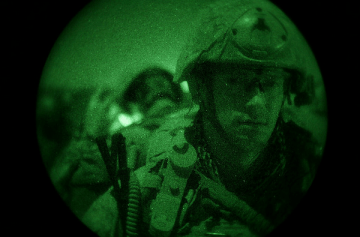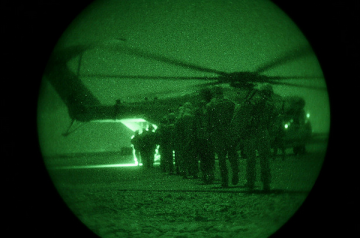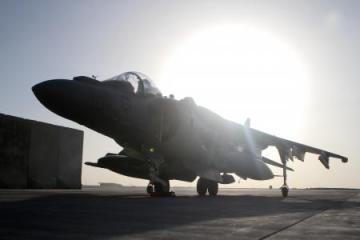A soldier keeps a watchful eye on a road outside Camp Bastion, Afghanistan.
Last weekend, a band of 15 Taliban fighters attacked Camp Bastion in Afghanistan’s Helmand province and killed two Marines while inflicting the most damage on U.S. warplanes since the Vietnam war’s Tet offensive 44 years ago.
There are several things worth noting about the brazen strike on the huge U.S.-British post. It carries lessons for the Afghan war, and perhaps all such wars where the U.S. paradoxically finds itself a superpower pinned down by its military might and vulnerable to such audacious tactics.
— Camp Bastion is isolated, surrounded by the Helmand desert so that an enemy’s approach can be detected and stopped. The Taliban attackers apparently eluded discovery as they prepared for their assault by posing as maize farmers in the weeks before they decided to strike, and by approaching the base via natural contours in the terrain that minimized their chances of being detected. When they struck, they were disguised, once again: in U.S. Army uniforms.

Marine Photo / Cpl. Aaron Rooks
— The U.S. military likes to say it “owns the night.” The attack happened about 10:15 p.m. local time Friday, Sept. 14, suggesting that, at best, the U.S. can only lease the night. How the attackers eluded drones, night-vision gear and a plethora of sensors supposedly shielding Bastion from surprise attack remains a key concern inside the U.S. military.
— The attackers blasted their way through Camp Bastion’s outer wall, before targeting the guard towers. They broke into three five-man teams that headed straight for the warplanes, hangars and refueling stations that were their targets, many of which they destroyed with their PKM General Purpose Machine Guns, AK-47 Rifles and rocket-propelled grenades.
“I went outside after hearing the first explosion and within 15 seconds I heard another explosion,” Lieutenant Colonel Stephen Lightfoot, commanding officer of Marine Light Attack Helicopter Squadron 469, said in a just-released Marine account of the attack. “That’s when I saw the flames on the Harrier flightline…It was a very dark night — there was no moon,” he said. “However, on the flightline there were multiple aircraft on fire and a couple other areas were on fire as well, so it was extremely bright. There were 50-to-100 foot flames and a lot of thick smoke.”
The eight AV-8Bs lost or severely damaged represented 8% of the Marines’ jump-jet fleet. Replacing them would cost more than $500 million. After four hours of combat, 14 of the insurgents were dead and one was captured.
— AV-8B Harrier pilot and Marine Lieut. Colonel Christopher Raible, 40, and Sergeant Bradley W. Atwell, 27, died in an explosion during the attack. Raible was the top officer of Marine Attack Squadron 211, the unit whose planes were targeted. The six AV-8Bs destroyed and two significantly damaged marked the toughest day for the unit since December 8, 1941 – the day after Pearl Harbor – in Japan’s initial assault on Wake Island, when VMA-211 lost 11 warplanes.
In his published command guidance, Raible told his Marines to show “moral courage”:
Speak up if something seems wrong or unsafe. We all know what the standards are supposed to be in Naval Aviation and in the Corps. Enforce them! When we fail to enforce the existing standards, we are actually setting and enforcing a new standard that is lower.
Marines are wondering if someone was derelict for letting the attack happen, and — if so — whether anyone will be held accountable.
— The attackers were, by all accounts, well-trained and led.
— They also were motivated: the attackers were wearing suicide vests, while the U.S. defenders were wearing protective body-armor vests. “It’s pretty clear that it was well-planned,” Australian army Brigadier General Roger Noble told Pentagon reporters last week. “It’s pretty clear that reconnaissance was done prior to. And like any good attack, it selected an approach looking for a weakness or a vulnerability in a particular position, and it’s exploited those things.”
— The attack has gotten relatively little attention. Unlike Tet, which was captured on U.S. network television cameras and broadcast into the nation’s living rooms in 1968, the Camp Bastion attack wasn’t documented as it happened by the press.

marine photo / Cpl. Aaron Rooks
It certainly happened inside the U.S. military, which ignores what transpired at its peril. Military airbases – big, static and generally lightly-defended – have long been tempting targets for the enemy. They will grow even more appetizing as precision-guided munitions, ranging from guided missiles to GPS-guided mortar rounds, find their way down the food chain of war.
“Prospective adversaries are developing and fielding, or have ready access to, military capabilities that will place U.S. forces operating from large, fixed forward bases, and in the littoral regions, at increasing risk,” the Center for Strategic and Budgetary Assessments warned nearly a decade ago. “Consequently, the Pentagon faces new challenges to the operations of air and land forces from overseas bases…even more disconcerting is the growing proliferation of national and commercial satellite services and missile technology. Increased access to these satellite services will allow even regional rogue states both to pre-target key fixed facilities and to monitor U.S. deployments into forward bases.”

Marine photo / Cpl. Timothy Lenzo
While it may seem safer waging war from behind the blast walls and concertina wire of major military bases, technology is increasingly making those concentric defenses look less like protection and more like a target.


